The structured precision of science and wild creativity of art rarely collide so elegantly as in Dr. Hunter O'Reilly's exhibit \Radioactive Biohazard: Reinterpreting Biotechnology as Art.""
The controversial exhibit, opening today in the Porter Butts Gallery at Memorial Union, explores the benefits of science through the expression of art.
Mixed media such as oil paint, animal bones, laboratory equipment and neon lights portray science in a form other than the written word and provide a unique way to explore the ethical issues of biotechnology.
Artists, scientists and the general public typically react to the exhibit in different ways, according to O'Reilly. ""Everything is integrated--art and science, but they react to different things depending on their background,"" she explains.
Visitors to the exhibit enter a world where deadly viruses are dazzling and animal bones and laboratory equipment become works of art. O'Reilly blends the realms of art and science further by inviting visitors to the gallery to don white lab coats so they can feel like a part of the artwork.
O'Reilly's work has been shown internationally and featured on the cover of the magazine ""Nature Reviews Genetics.""
She first became a serious artist while in graduate school at UW-Madison. Frustrated with her research, O'Reilly went to Paris with her father and found inspiration to integrate art and biology. O'Reilly received her Ph.D. in genetics from UW-Madison in December 2000. She currently teaches courses in biology and art at UW-Milwaukee. In one of her courses, students study general biology through art and ultimately create biological portraits of themselves.
In ""The System Forgets Scientists Are Only Human: Laboratory Installation,"" O'Reilly conveys the excitement, frustration and irony of scientific research. The exhibit is a laboratory bench complete with lab equipment, preserved laboratory animals, chemical bottles and Aerosol Resistant Tips for pipettes, conveniently abbreviated on boxes as ""ART.""
Post-it notes on the bench show struggles of inventive graduate student working in the lab through seven years of research, discoveries and dead ends. One note reading, ""Every graduate student in molecular biology should be issued a candy dispenser of Prozac. Increase dosage when needed,"" lies next to a Tic-Tac container mixed with breath mints and anti-depressants. O'Reilly uses the laboratory setting and story told by the Post-its to show how more support and encouragement throughout the research process could help the scientist keep the initial excitement of experimentation.
Many of O'Reilly's pieces use digital art to integrate microscopic images and photographs which combine to make a statement about science and society. One such piece is a portrait of Randolfe Wicker, an advocate for human cloning since the 1970s, who told O'Reilly she was his Andy Warhol and he her Marilyn Monroe.
""Let My Family Live! Portrait of Randolfe Wicker, the First Human Cloning Activist"" depicts Wicker at different stages of life labeled as a grandfather, father and son. Another image, ""A Clone Is Not a Copy,"" shows cc, the first cloned cat, with the adult cat from which she was cloned. The cat's fur pattern is noticeably different despite identical DNA. Through art, these pieces convey O'Reilly's assertion that a human clone would still be a unique individual.
One of the most striking works in the exhibit is the digital art piece ""Rosalind Franklin and the Discovery of DNA Structure."" The most prominent image in this piece is a red photo of Franklin, who played a critical, though often unheralded role in the discovery of the structure of DNA. A photo of James Watson and Francis Crick, the most well known of the scientists responsible for the DNA discovery, is placed symbolically within Franklin's face. Vivid red and blue images of chromosomes and X-ray crystal photographs put the portrait of Franklin in a scientific context.
Another stunning display makes the unusual claim ""The Art of Death: Viruses Are Beautiful!"" A set of five enlarged, brightly colored electron micrographs of viruses such as ebola and HIV may look like candy or aesthetically pleasing abstract art to the untrained eye. The display often elicits a strong reaction from viewers once they realize what they are seeing.
""A lot of times the reaction is to step back,"" explains O'Reilly, who likes the paradox of the visually beautiful yet devastating viruses. ""Things that are beautiful are not necessarily always good, things that are ugly are not always necessarily bad.\





